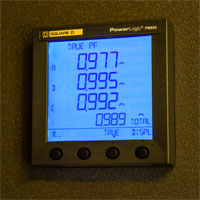How we meter

Most meters on Grounds are installed and maintained by UVA Facilities Management. Meters are typically for internally-generated/distributed commodities such as electricity, steam, hot water, chilled water and water. There are also vendor-provided meters for buildings served by external accounts, or “direct drops,” such as for electricity, natural gas, oil and water.
Facilities Management’s Metering & Billing team measures and collects energy management data and maintains the utility metering systems throughout the University. The team works closely with the Automation Services team that maintains the building automation systems (BAS). Energy management and sustainability goals are supported through the use of over 1,200 physical meters that measure and record commodity consumption. Approximately 80 percent of meters are connected to the BAS allowing continuous reading and trend recording without the need to physically visit and read each month. The collected data is used for profiling loads, identifying metering anomalies and troubleshooting.
The University strives to provide the highest level of metering services for its customers and uses metering data to target sustainability initiatives and document progress and success. High-quality metering devices are installed and the metering team performs routine preventive maintenance and analysis to improve data availability and integrity.
Standard billing units for various commodities
| Electricity | kWh (kilowatt-hour) Ten 100 watt light bulbs turned on for one hour use 1 kWh |
| Steam | MMBtu (millions of Btu’s or British Thermal Unit) M is Roman numeral (1,000) MM = 1,000x1,000 = 1,000,000 One Btu is about the energy released when a wooden match is burned completely |
| Chilled water | MMBtu (millions of Btu’s or British Thermal Unit) |
| Heating hot water | MMBtu (millions of Btu’s or British Thermal Unit) One Btu is the heat required to raise the temperature of one pound of water by one degree Fahrenheit |
| Domestic (potable) water | hGals (hundreds of gallons or hecto-gallons) The average person uses approximately one hGal per day |
| Sanitary sewer | hGals (hundreds of gallons or hecto-gallons) Older model toilets use over 3 gallons of water for each flush, while a low-flow toilet will only use 1.2-1.6 gallons |
| Natural gas | MCF (thousand cubic feet) – M is Roman numeral (1,000) MM = 1,000x1,000 = 1,000,000 Natural gas is measured by volume (cubic feet) but is sold based on its heating content (Btus) |
| Distillate oil | Gals (gallons) |
| Liquid propane gas | Gals (gallons) Being temperature dependent, liquid propane becomes more dense as temperature falls and expands as temperature increases |
University generated/distributed utilities are billed at a fixed rate per unit of consumption. These rates are set annually and are applied with each new fiscal year. External, direct drop account rates vary and can be based on market factors, such as with oil or natural gas, or be based on state-regulated tariff’s such as Dominion Virginia Power rates.